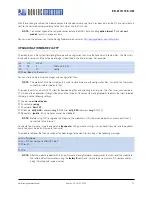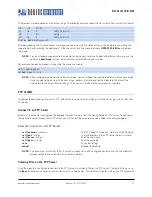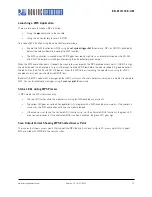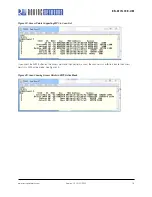
www.rovingnetworks.com
Version 1.0r 9/21/2012
84
RN -W IFLYCR -U M
RESTORING DEFAULT CONFIGURATION SETTINGS
You can restore the default factory configuration settings in software and hardware.
•
Software
—In command mode, use the factory RESET command to restore the defaults. This command
automatically loads the default settings and executes a save command. Next, send the reboot command so that
the module reboots with the default configuration.
•
Hardware
—Set GPIO9 high on power up to arm the factory reset function. Then toggle GPIO9 five (5) times,
which restores the configuration to the factory reset. GPIO9 is sampled at about 1 Hz; therefore, if you are using a
CPU to generate the signal, make sure that GPIO9 transitions (high to low or low to high) are at least 1 second
long.
You can specify a user configuration file as the factory reset settings. Prior to this firmware version only the hardcoded
factory defaults would be restored. If you have stored a configuration file named
user
, the module reads it as the factory
default instead of using the factory hardcoded defaults. If no
user
configuration file is present, the module uses the
hardcoded factory defaults.
You create the
user
configuration file using the
save user
command, which saves the current configuration settings into a
file named
user
.
Even if a user configuration file exists, arming and toggling GPIO9 7 times overrides the user settings and restores the
module to the factory hardcoded defaults. This bypass mechanism allows you to restore the factory defaults in case a bad
configuration is saved into the user file.
Issuing the
factory RESET
command while in command mode restores the module to a factory default state.
NOTE:
You must reboot the module or reset it for the new settings to take effect.











































